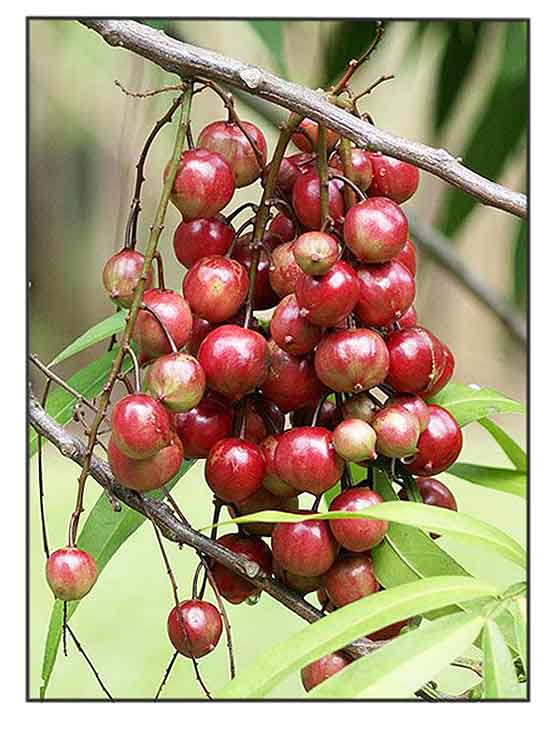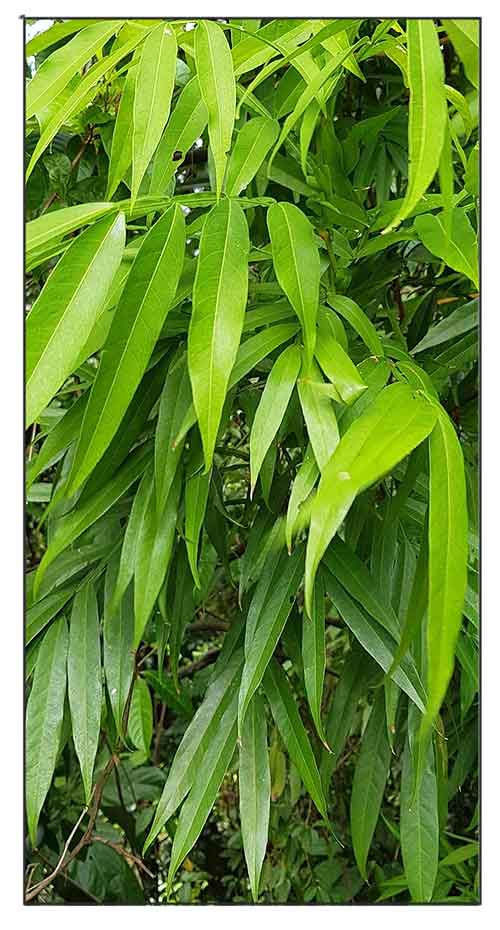 Gen info Gen info
- Lepisanthes is a genus of 24 or 25 species of trees or shrubs native to tropical Africa, south and southeast Asia, Australia, and Madagascar. It includes species previously classified under genera Aphania, Erioglossum, and Otophora. (3)
-
Lepisanthes alata is a species of flowering plant, a tropical forest fruit-tree in the lychee family, native to Southeast Asia. (2)
- Etymology: The genus name Lepisanthes derives from Greek words lepis, meaning "scale, flake", and anthos, meaning "flower", referring to the scales at the apex of the petals. Species epithet alata is Latin alatus, a, um, meaning "winged" referring to the winged rachis.
Botany
• Lepisanthes alata grows as a small monoecious tree to 5–15 m in height. Pinnate leaves have 5–13 pairs of usually sessile, lance-shaped to oblong leaflets. Pendulous inflorescences bear wine-red to purple flowers. Fruits are oval drupes, 2–4 cm long by 2–3 cm in diameter, red to purple when ripe, each containing two seeds in an edible, sweet, white mesocarp. (2)
• A tree up to 15 m tall. Foliage: Leaves are compound, 20-45 cm long (occasionally to 100 cm), with 8-12 pairs of leaflets. Main stem of the leaf is glabrous and winged on both sides; wings are 3-8 mm wide. Leaflets are ovate-lanceolate to lanceolate, oppositely or sub-oppositely arranged, with pointed tips and entire margin. Young leaves are pinkish-purple, turning green when mature. Flowers: Monoecious (male and female flowers on the same plant). Flowers are borne in clusters which grow up to 45 cm in length, scentless, with 5 purple to wine red colored petals. Fruits: Trigonous-obovoid with a pointed tip, measuring about 2.5-4 cm in diameter. Mature fruits are red in color, with translucent fleshy pulp. (8)
Distribution
- Native to the Philippines and Borneo.
- Introduced into Jawa and Malaya.
- In forests along water streams, up to 500 m altitude.
 Constituents Constituents
- Phytochemical isolated from L. alata include: flavanol (epicatechin), flavanonol (taxifolin-3-O-hexoside), flavanone (eriodictyol-7-O-rutinoside; eriodictyol-O-hexoside I,II,III), flavonol (myricetin-3-O-rutinoside, quercetin-3-O-rutinoside, quercetin-3-O-glucoside, kaempferol-3-O-rutinoside, isorhamnetin-3-O-rutinoside, quercetin-3-O-rhamnoside, quercetin, quercetin-4’-O-galactoside), flavone (luteolin-7-O-hexoside), isoflavone (neobavaisoflavone, daidzein, genistein), anthocyanin (cyanidin-3-O-sophoroside, cyanidin-3-O-glucosylrutinoside, cyanidin-3,5-O-diglucoside, cyanidin-3-O-rutinoside-5-O-glucoside, delphinidin-3-O-neohesperidoside, cyanidin-3-O-glucoside, cyanidin-3-O-rutinoside, peonidin-3-O-glucoside, cyanidin-3-O-pentoside, cyanidin-3-O-(2”’-acetylrutinoside), cyanidin-3-O-(6”-acetylglucoside), delphinidin-3,5-O-diglucoside, delphinidin-3-O-(6”-coumaroylglucoside), delphinidin-3-O-rutinoside, cyanidin-3-O-glucoside-5-Opentoside, cyanidin-3-O-glucoside-7-orhamnoside, petunidin-3-O-rutinoside), phenolic acid (caffeic acid-4-O-glucoside, vanillic acid-4-O-glucoside, ferulic acid-4-O-glucoside, (2Z)-6-[5-(b-D-Glucopyranosyloxy)-4-hydroxy-2-methylphenyl]-2-methyl-2- heptenoic acid), other compounds (mangiferdiol, 3-Isopentadienyl-3’,4,5’-trihydroxystilbene, Verbasoside, Primulaverin, Astringin), tannin (Methyl 4-O-galactopyranosyl-2,3-di-O-methyl-galactopyranoside Benzyl alcohol-hexosidepentoside I, II, Primeveroside, Jasminoside R, Pinellic acid, Equol). (7)
- Nutrient analysis of ripe fruit yielded: moisture 77.7%, dietary fiber 9.5%, ash 0.8%, total sugar 9.8%, and vitamin C 16 mg/100g (Upho 2005). (9)
Properties
- Studies have suggest antioxidant, antibacterial, antidiabetic, α-amylase, α-glucosidase inhibitory activities.
Parts used
Leaves, fruits, seeds.
Uses
Edibility
- Fruits is edible; fruit pulp is sweet when ripe.
- In Thailand, young leaves cooked and eaten as vegetable.
Folkloric
- No reported folkloric medicinal usage in the Philippines.
- In East Kalimnatan, leaves used to reduce itching due to scabs.
- Fruits used for treatment of fever, constipation, dysentery, debility and flatulence.
 Studies Studies
• Polyphenolic Content / Toxicity Testing / Antioxidant Activity: Study evaluated the polyphenolic content, toxicity, and antioxidant activity of L. alata fruits. Polyphenol content was highest in whole fruit (2.87 mg GAE/g DW), lowest in the flesh (0.64 mg GAE/g DW). Anthocyanin content was highest in the rind (1462.82 mg/100g FW) and lowest in the flesh (627.27 mg/100g FW). Epicatechin was the major catechin in the whole fruit. Ethanol extract of bark showed highest DPPH radical scavenging activity. Toxicity testing by Brine Shrimp Lethality Test (BSLT) showed lowest LC50 for the whole fruit extract (1600mg/mL), indication safety for consumption. Results suggest a source of natural antioxidant supplement in processed foods to protect against free radicals. (4)
• Proantocyanidins / Antidiabetic / α-Amylase and α-Glucosidase Inhibitory Activity: Lepisanthes alata is an edible plant with high starch hydrolase inhibition activities for corn starch hydrolysis with aqueous extract IC50 of 0.77 µg/mL for porcine α-amylase, and 10.83 µg/mL for rat intestinal
α-glucosidase. Proanthocyanidins were identified as the active compounds. Inhibition kinetic study showed the proanthocyanidines were a mixed noncompetitive inhibitor against α-amylase but competitive inhibitor against α-glucosidase. Results suggest potential of L. alata for prevention of post prandial hyperglycemia. (5)
• Proantocyanidins / Effect of Fruit Ripening / Fruits: Bioactive proanthocyanidins are the main inhibitors of starch hydrolases in unripe and ripe Malay cherry fruits. Proanthocyanidins from unripe and ripe fruits showed stronger inhibition of α-amylase with IC50s of 3.54 and 1.19 µg/mL, respectively, than that of α-glucosidase. Mean degree of polymerization (mDP) of proanthocyanidins increase from 8 to 18 as fruit ripened. Larger proanthocyanidins (higher mDP values) in ripe fruits exhibited significantly stronger inhibition of α-amylase and α-glucosidase than less polymerized proanthocyanidins in unripe fruits, indicating the dependence of inhibition on mDP. Total phenolics and total anthocyanidins significantly decreased as fruit ripened. (6)
• Antioxidant / Antibacterial / Seeds: Study evaluated the antioxidant and antibacterial activity of 60% ethanol peel, flesh and seed extracts of Ceri terengganu. The seed extract showed highest TPC, TFC and antioxidant activity, followed by peel and flesh extract. The peel extract showed highest total monomeric anthocyanins content. All three extracts inhibited selected test pathogens viz. S. aureus, B. cereus, and B. subtilis. The seeds showed greatest potential as natural antioxidant and antibacterial agent for the food industry. (7)
Availability
- Wild-crafted.
- Ornamental cultivation.
|

![]()





 Studies
Studies 